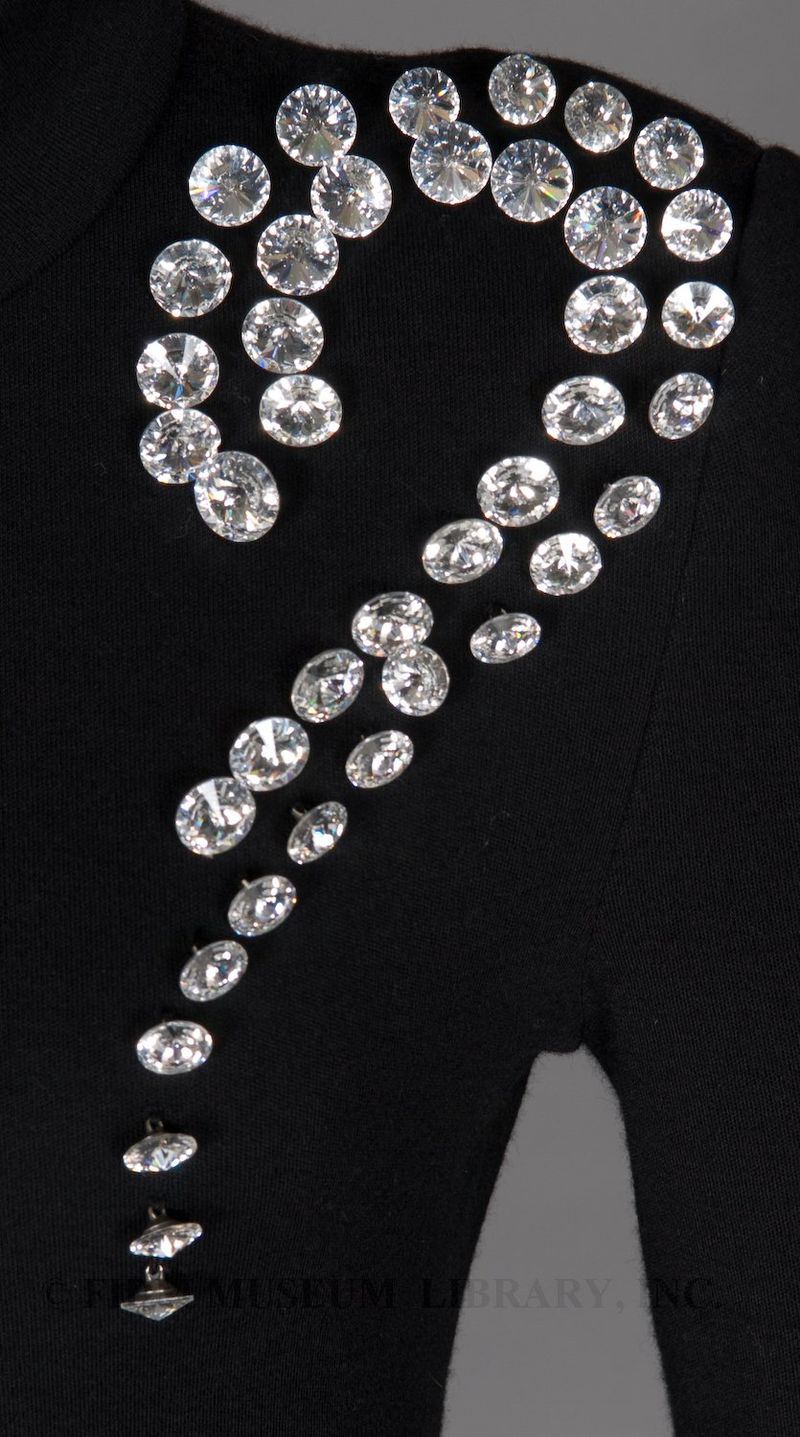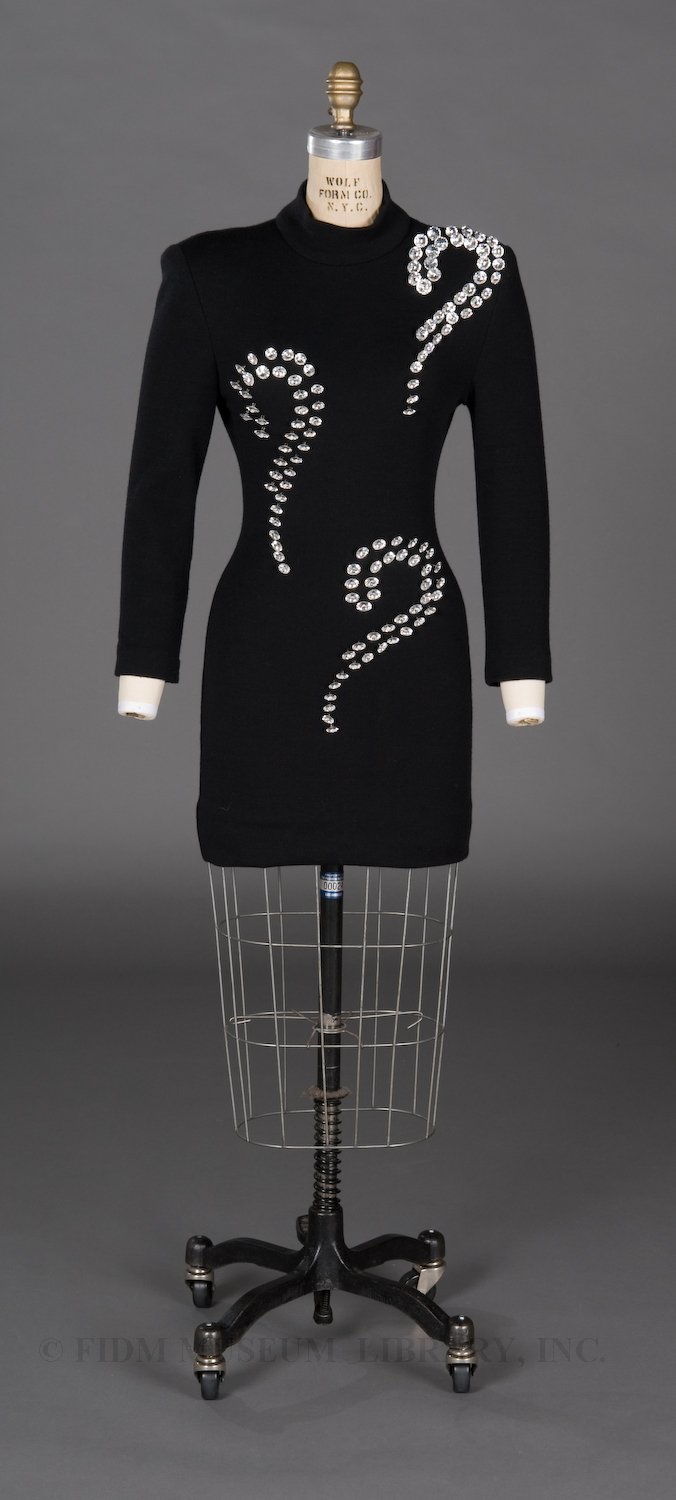Patrick Kelly’s (1954-1990) irreverent mini-dresses embellished with buttons, bows or rhinestones were his most iconic creations. One 1988 version featured tiny billiard balls sewn to the bodice! When interviewed, Kelly always credited his grandmother with the inspiration for using everyday objects as embellishment. As a child in Mississippi, Kelly frequently lost his shirt buttons. His grandmother would replace them, but the buttons never matched. When Kelly complained, his grandmother “started putting different buttons everywhere” to distract from the mismatched buttons. 1
Wool minidress
Patrick Kelly
c. 1986
Museum Purchase
2007.5.14
Kelly’s choice of colorful, eye-catching embellishments were part of creative philosophy that emphasized a playful approach to fashion. Despite (or because of?) their theatrical embellishments, Kelly’s designs were popular with fashion commentators, models (who were reportedly willing to accept clothing in lieu of other payment for walking in Kelly’s shows) and customers. According to a Macy’s buyer interviewed in 1989, Kelly’s “clothes fly out of the store.” 2 Even Bette Davis appreciated Kelly’s aesthetic, wearing a Kelly button dress for a 1987 appearance on David Letterman. In 1988, Kelly became the first American designer to be admitted to the Chambre Syndicale du Prêt-à-Porter des Couturiers et des Créateurs de Mode, the prestigious French organization which governs the French fashion industry.
 2007.5.14 Embellishment detail
2007.5.14 Embellishment detail
Like many other creative African-Americans, including Josephine Baker, Kelly achieved success only after moving to Paris. Once Kelly had been legitimized by the Paris fashion establishment, his work gained a wide following in the United States. Despite this relocation, Kelly frequently acknowledged his heritage, often repeating a version of the statement, “I design differently because I am Patrick Kelly, and Patrick Kelly is black, is from Mississippi” in interviews. His personal uniform of oversize overalls spoofed the stereotypical uniform of a Southern farmhand, while his choice of decorative motifs often included racially loaded imagery such as watermelon wedges, patterned bandanas and the golliwog icon. At public appearances and fashion shows, Kelly often gifted small pins featuring an African American baby, an icon he also used as a decorative motif on garments.
For more images of Patrick Kelly garments, visit the Brooklyn Museum’s archive for their 2004 exhibition Patrick Kelly: A Retrospective.
1 Hyde, Nina. “From Pauper to the Prints of Paris.” The Washington Post 9 Nov. 1986: G1.
2 Hyde, Nina. “Fashion.” The Washington Post 17 Mar 1989: D1.



Fascinating! I have long admired Kelly’s work, but had no idea that he was the only American to have been accepted into the Chambre Syndicale.
Thank you for the information
Hi Petra,
I should clarify that Patrick Kelly was the first (not the only) American to be admitted into the Chambre Syndicale. Currently, Rick Owens (from Southern Califronia) is a member, and I believe there have been other Americans since Patrick Kelly.
I think it’s high time that someone wrote a book about Patrick Kelly! There is a A LOT of primary source information about him out there, but no comprehensive, scholarly source. Any takers?!?
Perhaps that book ought to come from you!
Patrick and I were classmates in Vicksburg, MS. I know there is a ‘collection’ of his housed in the city and I also know he has a number of relatives in and around the area. Yes, someone needs to write a book about his life, beginning with humble beginnings in the small, unwavering town in Warren County!
Deborah, it’s great to know that Patrick Kelly’s hometown feels his work is/was important enough to take care of and collect. Still hoping a book on his work will be forthcoming.